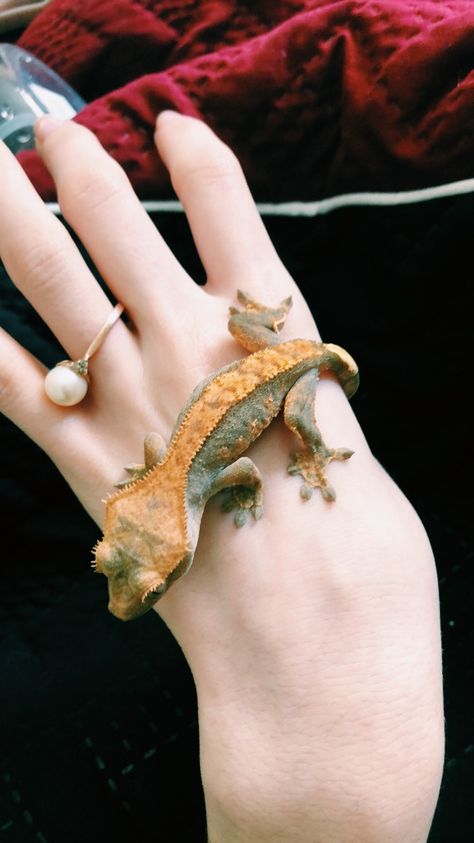What to feed baby red tail catfish
Feeding, Setup, Tank Mates & More
Red tail catfish are a favorite of aquarists in love with monster fish. They start out small and cute but grow to be absolutely massive. And in the process of getting bigger, they often end up eating several of their tank mates. While they are not sensitive fish, all of these elements make their care very complicated.
Can you deal with a 4-foot long predator that needs hundreds to thousands of gallons of space? Let’s take a closer look at the large and in-charge redtail catfish.
In This Article
- Getting to Know the Red Tail Catfish
- Redtail Catfish Care
- Minimum Tank Size
- Water Parameters for Red Tail Catfish
- Aquascaping for Redtail Catfish
- Redtail Catfish Tank Mates
- Feeding Redtail Catfish
- Breeding Redtail Catfish
- In Conclusion
- More Frequently Asked Questions about Red Tail Catfish
Getting to Know the Red Tail Catfish
Red tail catfish are some of the largest fish that are commonly found in the aquarium trade. Native to South America, they are found mostly in Venezuelan river basins. Here they go by the local name of cajaro. And in Brazil they are known as pirarara.
In their natural habitat, they are rarely hunted for food by the locals despite being edible because their dark flesh is seen as a sign of not being of good quality. However, redtail catfish have been introduced to tropical places around the world. In Southeast Asia, they are a favorite game fish and are eaten with delight.
South American redtail catfish are members of the family Pimelodidae, which is a group of small to large catfish that are predominantly fish-eating predators. Others in the group include the much smaller Pictus Catfish and the equally long but much more slender Tiger Shovelnose Catfish.
Other Pimelodid catfish species show up in the hobby now and again. But these three fish species are by far the most common compared to the others.
You may also see the Asian Redtail Catfish (Hemibagrus wyckioides) for sale sometimes. This is a much rarer, unrelated freshwater fish species that look quite different as well.
This is a much rarer, unrelated freshwater fish species that look quite different as well.
Asian Redtail Catfish also grows huge, surpassing 4 feet in length. However, they are slimmer than “true” redtail cats and they have a pale grey body that’s nothing like the bright black and white of the South American redtail catfish.
All in all, these fish species aren’t especially difficult to care for. Redtail catfish are exceptionally hardy and eager eaters. The main issue is that they require aquariums of 500 gallons or more as they mature, something well out of reach of the average aquarist. That said, if you’re ready to take on such a challenge, you’ll have an impressive pet that will live for up to 15 years.
- Scientific Name: Phractocephalus hemioliopterus
- Origin: South America in major river basins
- Length: 4 to 6 feet
- Aquarium Size: 500+ gallons
- Temperament: Semi-aggressive; Predatory
- Ease of Care: Moderate
Redtail Catfish Care
Redtail catfish care is both easy and difficult. Easy because they are fast growers and eager eaters. They are tolerant of a wide range of aquarium water conditions and don’t need much in terms of special care. But they can also be very difficult because they grow absolutely massive and will eat most of the other fish in your tank if you aren’t careful.
Easy because they are fast growers and eager eaters. They are tolerant of a wide range of aquarium water conditions and don’t need much in terms of special care. But they can also be very difficult because they grow absolutely massive and will eat most of the other fish in your tank if you aren’t careful.
Minimum Tank Size
A juvenile redtail catfish can be less than two inches long and looks adorable, with its black, white, and red patterns. But there’s no getting around the main difficulty to keeping red tail catfish: they grow fast and massive. 3 feet is on the smaller end for them, with 4 feet being a solid average. And in the unlimited confines of their home Orinoco and Amazonian River systems, they can reach up to six feet long.
Worse, that growth is incredibly quick. Redtail catfish size as a baby is just a few inches long. However, it will double its length in 2-3 months. In a year it will be fairly massive and by the next, you’ll need a yardstick to measure its length
That means the minimum tank size for an adult redtail catfish is at the very least 500 gallons in size.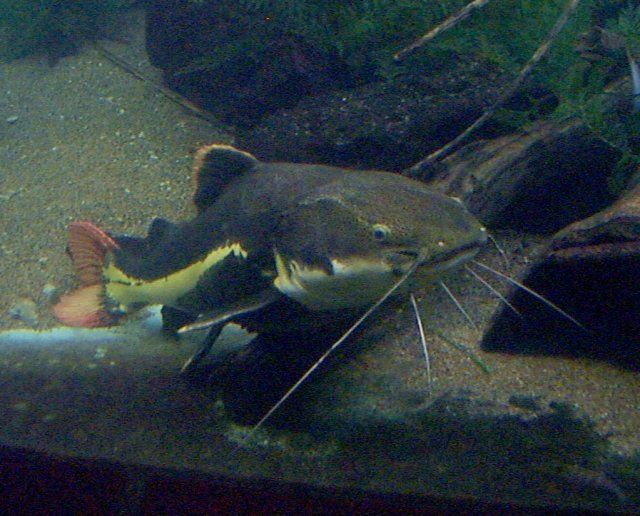 Probably larger, given the need for your fish to be able to turn around comfortably.
Probably larger, given the need for your fish to be able to turn around comfortably.
Many red tail catfish keepers place theirs in ponds – though you’d need to either be living in a tropical region or have a heated indoor pond to do so successfully.
A pond is an excellent way to provide perfect redtail catfish care because the walls can curve so they aren’t constantly running into them. Ponds hold much more water than all but the largest aquarium setup. And they offer much more space for you to choose equally large fish as tank mates for a redtail catfish.
Water Parameters for Red Tail Catfish
When it comes to water parameters red tail cats prefer conditions close to their native South American waters. That means soft conditions with moderate to low dissolved hardness (GH & KH), and moderate acidity (pH 5.5-7.0). That said, they are not picky and will continue to thrive even in the hard, alkaline water found in most tap water systems.
This adaptable nature can make them a problem in other parts of the world. So long as the conditions are right redtail catfish will survive and thrive. This can be a very big problem for local species that are not used to a new super-predator on the block.
So long as the conditions are right redtail catfish will survive and thrive. This can be a very big problem for local species that are not used to a new super-predator on the block.
Water temperature, on the other hand, needs to remain elevated. 74-82℉ is an ideal range for them; avoid cooling them below this point. Like all fish, red tail catfish are endothermic, meaning their bodily systems are regulated by the outside water temperature. Cold water can slow down their digestion so much that food begins to rot within, causing bloating disorders that can easily be fatal.
The main thing to watch out for is ammonia levels. Redtail catfish are massive predators with an equally massive appetite. You will be shocked by how much these fish can put away – and how much comes out the other end. This means that they continually produce large amounts of nitrogenous waste which means you’ll need a substantial filtration system to keep it all under control.
Canister filters are the only real option; even the largest power filter won’t be able to process enough water to keep ammonia, nitrite, and nitrate levels at a healthy level. A canister filter can hold a few gallons of filter media, enabling it to scrub the water free of any pollutants.
A canister filter can hold a few gallons of filter media, enabling it to scrub the water free of any pollutants.
Power filters only work for baby redtail catfish, which can also be kept in smaller tank sizes. But you are only putting off the inevitable and it is better to invest in a large tank size and a proper canister filter right from the beginning.
Aquascaping for Redtail Catfish
When designing a tank for a redtail catfish space will always be the most important quality. When fully grown these freshwater fish will be able to knock over just about any decorations except for a large rock or piece of driftwood.
You can try keeping them with live plants but they are too likely to simply be uprooted accidentally over time. Plants don’t like being disturbed so often and will eventually die from being abused so often. So it’s better to stick with plastic or silk plants, which have the added advantage of not needing specialized full spectrum plant lighting.
If you are determined to keep live plants in a redtail catfish aquarium then you should stick mostly to epiphytes. These are plants that grow on hard surfaces like rocks and driftwood. And once they are established they are almost impossible to rip free.
These are plants that grow on hard surfaces like rocks and driftwood. And once they are established they are almost impossible to rip free.
Popular epiphytes include Java Fern and Anubias. These plants also don’t need much in terms of lighting and are great low-light plants. Aquatic mosses like Java Moss will also do well in a redtail catfish aquarium.
Sand is the best substrate for redtail catfish of all sizes. While they don’t do much digging, gravel can sometimes get swallowed alongside a live fish meal that gets pinned to the bottom. Once eaten these gravel grains can potentially block the intestinal tract, which is almost always fatal. Sand grains are small enough that, if eaten, they will be passed safely.
Another option that many redtail catfish keepers opt for is to do away entirely with a substrate. Bare bottom aquariums have a major advantage: they are extremely quick to clean! A few quick passes with the siphon hose are all that’s needed to remove the obvious feces left behind.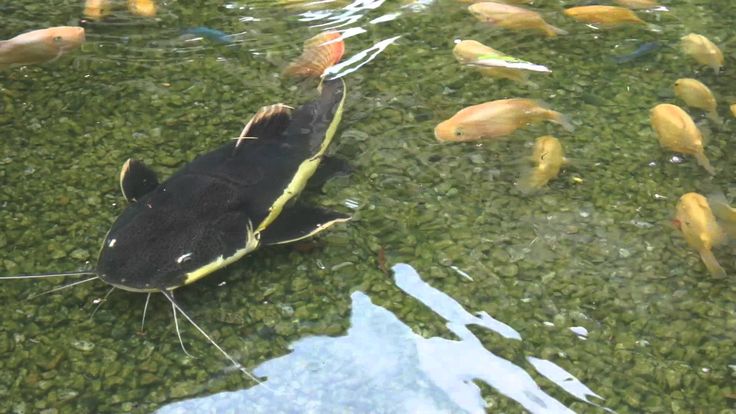 The main drawback is that it doesn’t look nearly as nice as a tank with a substrate, though.
The main drawback is that it doesn’t look nearly as nice as a tank with a substrate, though.
There is another reason why bare-bottomed tanks and ponds are so common besides ease of cleaning. By keeping things simple you won’t need to redo your aquascape every few weeks when the redtail catfish knocks things over. So be sure to take some extra time thinking about the substrate you have in mind!
Redtail Catfish Tank Mates
Choosing tank mates for redtail catfish needs to be done very, very carefully. Because these fish have a wide mouth, broad head, a giant appetite, and are active at night when most of their tank mates will be sleeping. Even fast-moving tank mates may end up disappearing, swallowed in their sleep by a hungry redtail catfish.
When small they can be kept with wide-bodied freshwater fish of equal size. Tiger Barbs, Silver Dollars, Gouramis, and Angelfish are suitable tank mates until the red tail catfish outgrows them.
But their rate of growth makes any peace very short-lived; you’ll need to be proactive about moving them to larger quarters and/or removing their edible tank mates every few months.
If you don’t want tank mates that will need to be moved lest they be eaten then choose fish that grow equally fast and that do well in a larger tank setup. Potential options include larger cichlids like Oscars and Peacock Bass. Arowanas and Stingrays are other popular tank mates that are unlikely to be eaten.
While they are voracious, red tail catfish aren’t really aggressive. They get along just fine with most large fish and even other bottom dwellers. They will ignore most of their tank mates unless it’s time to eat.
Some aquarists do report that their redtail catfish have more “personality” than most, however. That’s not uncommon for large fish, which are more intelligent and tend to recognize their owners and have strong personality quirks.
Many pimelodid catfish are outright vicious, including the well-named Black Devil Catfish (Hemibagrus wyckii). But red tails do fine with anything they can’t outright eat.
Good Tank Mates for Redtail Catfish:
- Oscars, Peacock Bass, Umbees, and other Large Cichlids
- Arowanas, Pacu, adult Plecostomus, Stingrays, and other Large Fish
Poor Tank Mates for Redtail Catfish
- Most freshwater Community Fish
Feeding Redtail Catfish
As you might expect, feeding a redtail catfish is as easy as it gets. These catfish will eat just about anything that hits the water so long as it has some meat in it! Most aquarists use a prepared pellet food formula, which is a great base for their diet.
These catfish will eat just about anything that hits the water so long as it has some meat in it! Most aquarists use a prepared pellet food formula, which is a great base for their diet.
But take the time to carefully read the ingredients label because many, if not most, brands use a lot of grain and starch-based fillers, like potato and cornmeal. Redtail catfish are predators and can’t digest all of that ground-up plant filler. You want to see fish meal, shrimp meal, and other animal protein sources as the first few ingredients.
You absolutely should offer your baby red tail catfish animal flesh as well. When small you can start out with thawed frozen brine shrimp, bloodworms, and tubifex worm masses. But as they grow insanely fast, these won’t be enough in just a few months’ time.
Many aquarists then start offering feeder goldfish, rosy reds, and guppies from their local store. While live fish are a natural food source for them, I don’t recommend taking this approach.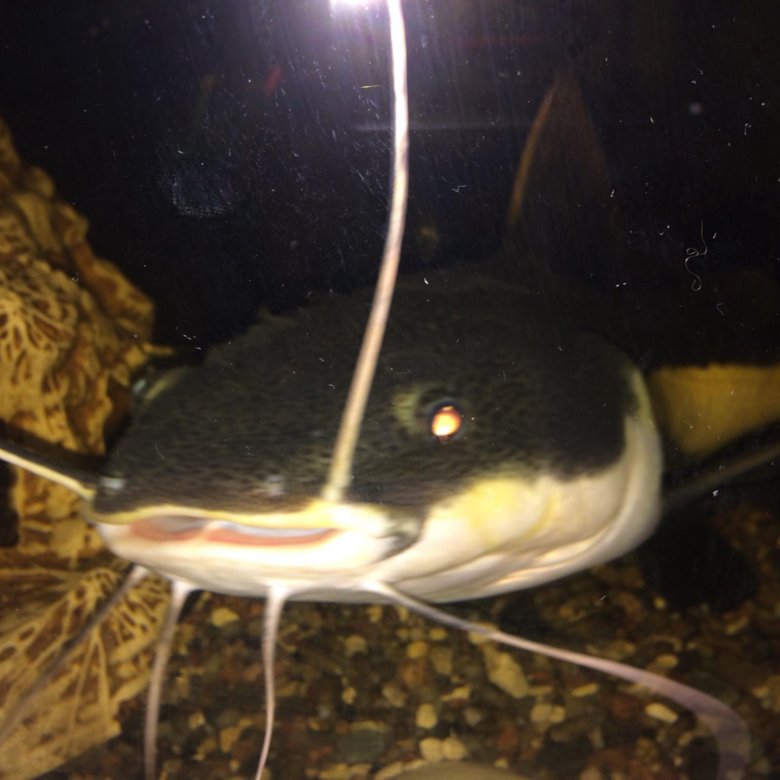 The problem with smaller fish is that they are kept in absolutely filthy conditions where parasites, bacteria, and fungal infections are the norm.
The problem with smaller fish is that they are kept in absolutely filthy conditions where parasites, bacteria, and fungal infections are the norm.
And when your red tail catfish eats one of these feeders they are potentially going to catch those same diseases. Unless you raise your own then don’t offer diseased food to your fish…
The best redtail catfish food is fresh meaty items like shrimp, scallops, and white fish. Stay away from chicken, pork, or beef, which are much too fatty. Stick to lean seafood only.
Breeding Redtail Catfish
Unfortunately, there are few to no examples of red tail catfish breeding in a home aquarium. These fish get too large to keep multiple side by side in anything but the very largest tanks. And their sexual characteristics are entirely unknown.
It’s likely that the red tail catfish can tell male from female fish using subtle behavioral cues and hormonal releases they pick up with their sensitive whiskers. But to us they appear identical; they aren’t sexually dimorphic fish.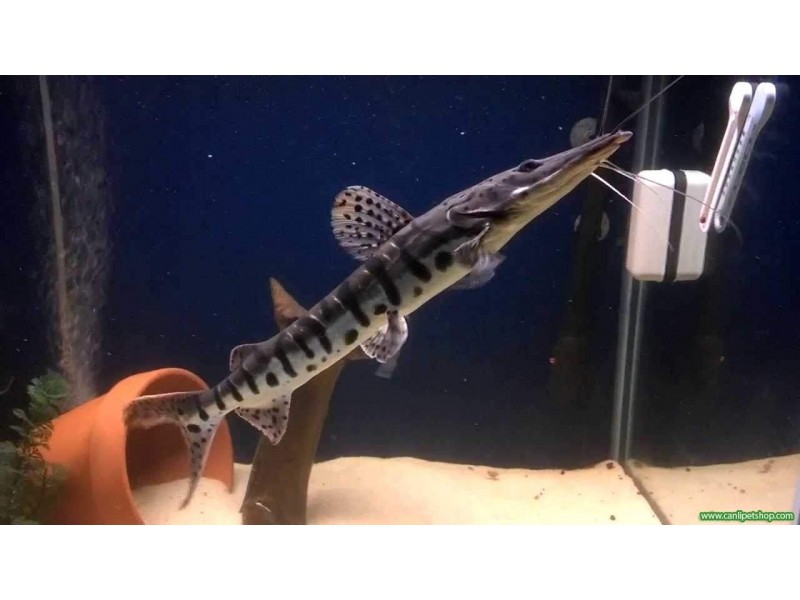
The breeding habits in the wild are also unknown. Many large Amazonian catfish in South America nest in mud holes along the river bank. The male will dig a nest using his tail for the female to deposit thousands of eggs within. The pair will then guard the eggs and often the fry once they’ve hatched for a few days or weeks until they grow large enough to fend for themselves.
For these reasons nearly all red tail catfish are wild-caught. Though if anyone were to breed them in captivity, it will likely be done using the methods being pioneered currently in Southeast Asia.
They keep several in a large outdoor pond in year-round tropical conditions. Sometimes hormonal injections are also used to stimulate egg and sperm production in adult fish. Since the demand for baby red tail catfish isn’t all that large there are no known captive breeding programs at present.
In Conclusion
Finally, we come to the last question: are redtail catfish right for me? Lovers of monster fish like Umbees, Pacus, and Oscars likely already know the answer – and have the space and resources required to successfully care for these mega fish.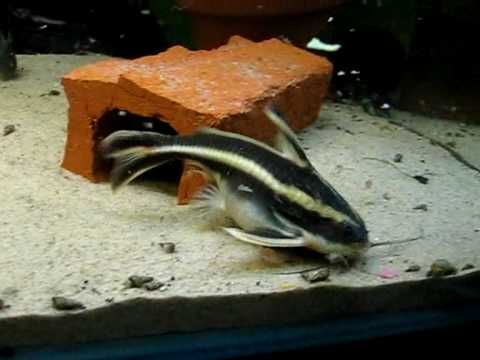
But for the average aquarist, you should think long and hard before buying that cute baby redtail catfish from your local pet store. You may think you’ll eventually upgrade to a larger tank. But that upgrade will come a lot sooner than you think. Remember, a young red tail catfish can put on 1-2 inches of length per month.
Unless you’re absolutely certain you’re ready for the 15-year commitment that keeping redtail catfish requires, you shouldn’t give in to the impulse. Sometimes people think that they can simply take the red tail catfish to a pet store or public aquarium once it outgrows their tank.
But sadly, they are often mistaken. Pet stores and public aquariums get calls from people looking to rehome large fish on a weekly basis. They may not even have the space or resources to take on a large animal like a redtail catfish.
And letting it loose in the wild is by far the worst thing you could do. Invasive species like red tail catfish can do massive amounts of harm. They can drive local species to extinction when they eat smaller fish and introduce captive diseases to the game fish population.
They can drive local species to extinction when they eat smaller fish and introduce captive diseases to the game fish population.
These freshwater aquarium fish are unlikely to survive in all but the warmest of countries. But condemning your poor adult redtail catfish to freeze during the winter is both unkind and very irresponsible.
So think carefully; and if everything sounds good, then get ready for a fun time with a catfish that’s more like an aquatic dog than any other fish.
More Frequently Asked Questions about Red Tail Catfish
Are you still thinking hard about redtail catfish care and whether you are up to the challenge? Then you’ve come to the right place. Here are a few more frequently asked questions on how to care for an adult redtail catfish.
How Big Does a Red Tail Catfish Get?
Redtail catfish are some of the largest fish available for a home aquarium. A small fish may be only a few inches long. But these fish grow large and they do so very fast. As an adult, a redtail catfish will be anywhere from four to six feet long.
But these fish grow large and they do so very fast. As an adult, a redtail catfish will be anywhere from four to six feet long.
Are Red Tail Catfish Good to Eat?
Redtail catfish are indeed edible and as delicious as any other fish. However, in their natural habitats, they are rarely eaten because locals find their dark flesh to be offputting. There have been experiments to hybridize them with tiger shovelnose catfish in order to create a new food fish. These hybrids sometimes show up in the aquarium trade labeled as Tiger Redtail Catfish.
What Fish Can Live With a Red Tail Catfish?
Redtail catfish are predators but they aren’t very aggressive. Any fish small enough to disappear into their mouth will eventually do so. But any other fish that is large enough will be safe alongside them. Large cichlids, catfish, pacu, arowanas, and other large aquarium fish are therefore the best tank mates for a redtail catfish.
Are Red Tail Catfish Venomous?
Most catfish have spines with venom glands along the base and the redtail catfish is no exception. There have been no studies on the exact qualities of the venom and how dangerous it might be to humans. Most pimelodid catfish stings feel at worst like a bee sting. However, the puncture is very prone to get infected and should be cleaned and treated properly.
Ghost Shrimp (Compete Care, Diet, Setup, & Breeding Guide)
X-Ray Fish (Pristella Tetra) Species Profile, Care, and Breeding
About Jason Roberts
Jason is an aquarium fanatic that has been a fish hobbyist for almost three decades.
Redtail Catfish Care: Diet, Size, Tank Mates, Diseases And More
The redtail catfish, otherwise known as phractocephalus hemioliopterus, is a type of catfish we see that is common in aquariums. It is native to South America and is interestingly the only surviving member of its genus – catfish phractocephalus.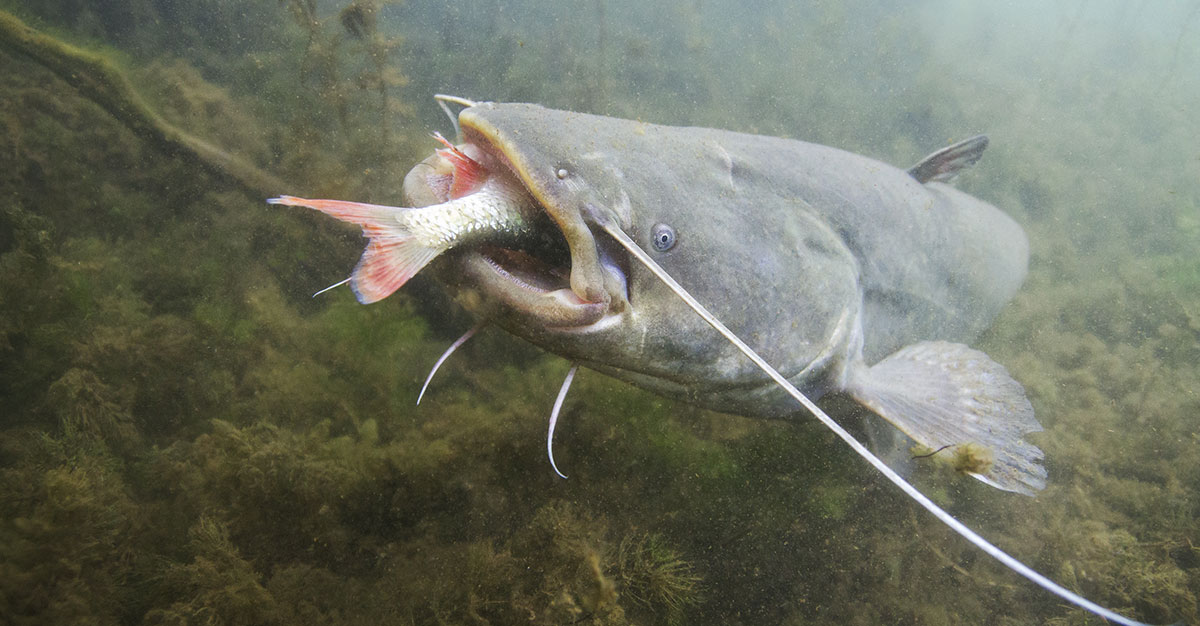 It makes most of South America its home and can be found in South American river basins in Ecuador, Guyana, Venezuela, Colombia, and more.
It makes most of South America its home and can be found in South American river basins in Ecuador, Guyana, Venezuela, Colombia, and more.
They are among the large aquarium fish we can see in the trade and are one of the fastest growing as well. Catfish are not known for their beauty, hence the term “catfished”, however, the phractocephalus hemioliopterus is actually considered one of the more attractive members of this family. Although the redtail catfish is often seen in the aquarium trade, it is very unsuited to tank life due to its sheer size.
Table of Contents
Redtail Catfish Overview
Let’s take a look at how to care for this large fish and familiarize ourselves with more details about this species.
| Information Chart | Redtail Catfish |
|---|---|
| Care Level: | Medium to difficult |
| Temperament: | Aggressive |
| Color: | Dark brown, grey with a thick yellow/white band |
| Lifespan: | 15 years |
| Size: | 3-4 feet |
| Family | Phractocephalus |
| Diet: | Omnivorous |
| Minimum Tank Size: | 31500-2000 gallons |
| Temperature: | 68-80 ºF (20-26 ºC) |
| Water Conditions: | pH 6-7 |
| Tank Mate Compatibility | Larger non-aggressive fish |
Appearance
Color
While they can be colorful, most of them feature shades of dark brown and/or grey with spots and a thick yellow/white band that runs along the length of their torso. Aside from the tail fins, the dorsal and caudal fins also feature hues of red and orange. Similar to other catfish species, the redtail catfish also features a flat underside.
Aside from the tail fins, the dorsal and caudal fins also feature hues of red and orange. Similar to other catfish species, the redtail catfish also features a flat underside.
As far as sexing goes, there don’t seem to be distinguishing marks to help breeders and aquarists determine if the catfish is male or female.
Lifespan of Redtail Catfish
Redtail catfish live relatively long lives. In captivity, data shows that they can live to about 15 years. It is assumed that they exceed this number in the wild due to more suitable environments. They are quite a demanding species of fish, and what they require may be difficult for aquarists to provide in-home tanks. This is a factor that can shave years off its life.
To create the perfect situation for these creatures to thrive, you need to pay attention to the different subsections we have listed below. We can say for now that to give them enough space, the right food and ideal tank conditions are crucial elements for the phractocephalus hemiolipterus to thrive.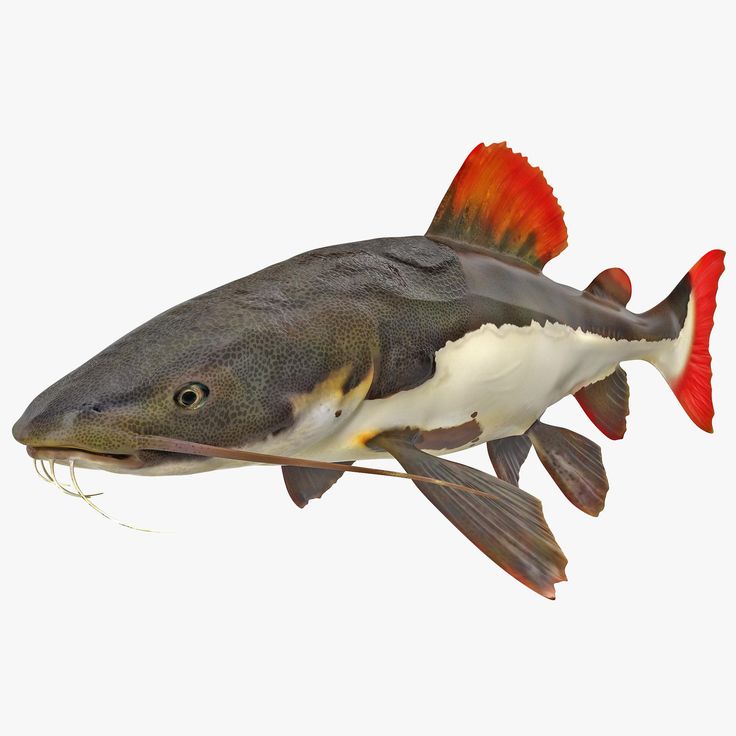
Remember that this particular catfish is native to South America, more specifically, in the river basins. This means that they are considered freshwater fish that need an aquarium with water and temperature similar to that in South America.
Redtail Catfish Size
How big can a red tail catfish get? As we previously mentioned, redtail catfish are quite large freshwater fish. Large enough to outgrow their initial tanks. The redtail catfish is said to be one of the more attractive catfish species with beautiful colors and, of course, a red tail. Similar to other catfish species, they also feature two barbels on their mouths.
How fast do red tail catfish grow? They grow quite quickly and to a pretty large size. You’re looking at at least an inch a week and they will be at least two feet in length in about a year. Keeping them in tanks limits their freedom of movement significantly compared to the wild, which is why they won’t grow as large in size as they would in the wild.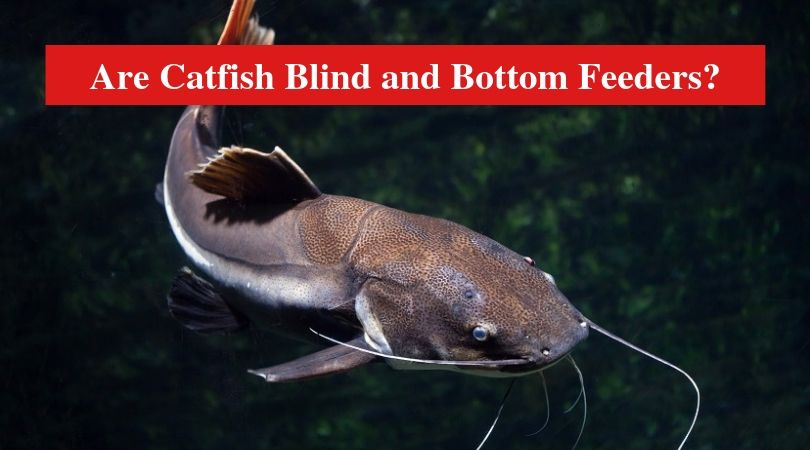 At best, they will be about 3-4 feet long, when in the wild they may reach up to a whopping 5 feet in total!
At best, they will be about 3-4 feet long, when in the wild they may reach up to a whopping 5 feet in total!
For a fish in captivity, 3 feet is gigantic. Not only in terms of the fish, but also in the tank size. It may be hard to search for a tank large enough to house the redtail catfish in just any aquarium store. A baby phractocephalus hemioliopterus is only about 5 cm, which is why a lot of aquarists are not aware of how large they may potentially be.
Aquarists may be under the misconception that keeping the redtail catfish in captivity at a young age could limit their growth. Although this is true, they will still most definitely reach at least 3 feet long. Regardless of how much “stunting” captivity has on your redtail catfish, the tank size will still need to be astronomical.
The largest recorded retail catfish in the world is measured at 4.62 feet and weighing in at an astounding 56 kg (123 pounds 7 ounces)! If you ever see pictures of these amazing catfish, you will be amazed by how large they can be compared to the average human male.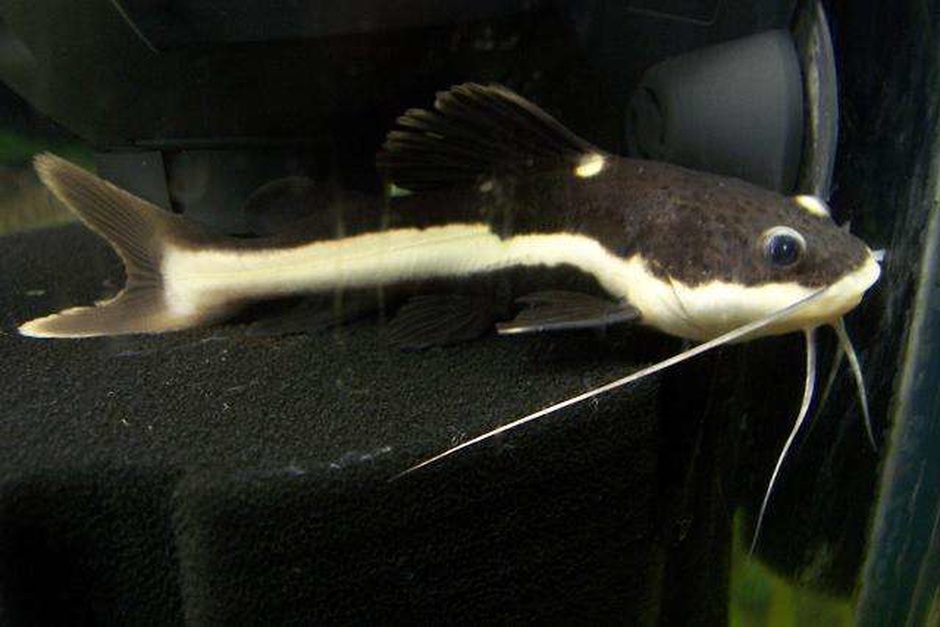
Natural Habitat and Origin
The redtail catfish is of the primelodidae family (whiskered catfish) under the phractocephalus family in the hemioliopterus genus. The experts say the RedTail Catfish is normally found in the Essequibo River, Orinoco, and Amazon River basins of Brazil, Venezuela, Guyana, Colombia, Ecuador, and Bolivia. Even though they live in the rivers, they can also be found in different habitats.
But they have now been introduced to other parts of the world, including Thailand. They can also now be seen in Florida as well.
Some experts say the Redtail Catfish are the only living member of the Pharactocephalus species. They are also called RTC, the banana catfish, the antenna fish, and the flat-nosed catfish.
Redtail Catfish Care & Tank Set-Up
Redtail Catfish Tank Size and Specifications
Minimum Tank Size
As we mentioned, this catfish with a red tail is not easy to care for. If you are determined to keep one in your home, here are a few things that are absolute musts. Just knowing the tank size may put you off a bit. In order to have enough room for ONE adult redtail catfish, the tank size you are looking at is about 1500-2000 gallons. No, we did not include an extra zero.
Just knowing the tank size may put you off a bit. In order to have enough room for ONE adult redtail catfish, the tank size you are looking at is about 1500-2000 gallons. No, we did not include an extra zero.
Since they get to about 3-4 feet, this is the adequate size to keep them happy and have enough room to roam. The tank size is definitely something that you cannot compromise on. With this, many people forget about ever owning a redtail catfish because a tank this big just isn’t doable for regular people.
The juvenile RedTail Catfish can grow much faster than other fish, around 1 inch in a week for the first two years. That’s why you may need to use a larger fish tank within a few months. But you should remember that upgrading your tana can be a little stressful for your fish. So, to help them ease the stress, you can transfer the water from the old tank to the new tank. This way, you can make sure that the parameters remain the same, and your fish will be able to adjust to the new environment.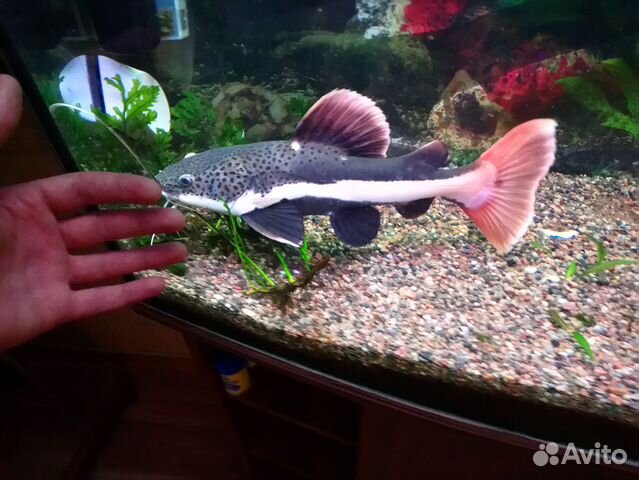
Besides, you can also have tank materials transferred from your old water filter system to the new one during cycling the tank. Before transferring your fish, you should finish the nitrification cycle.
If you want to add décor items to the aquarium, you should ensure they don’t have any swallowable parts. Use décors as large as your catfish to prevent them from trying to eat the items.
Because of their nature, they may like to destroy the décor. So, it will be better for you to use big rocks and large branches in the tank. An aquarium with nothing on its bottom will work great. However, if you think that looks dull, you can use sand to cover the bottom section.
On the other hand, as Redtail Catfish are not social-type, the tank’s lighting condition should be subdued. If you can’t do that, you should add more dens and caves to the tank to create hiding spots.
Water Parameters for Redtail Catfish
Temperature
As mentioned, redtail catfish are very resilient and can withstand and adapt to many conditions, but getting the water conditions just right will only further benefit the phractocephalus hemioliopterus.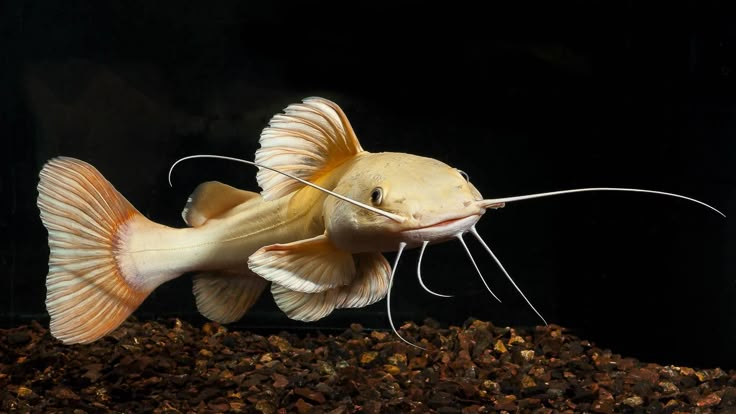 The ideal water temperature should be between 68 to 80 degrees Fahrenheit (20-26 degrees Celsius) with pH levels sitting between 6 and 7.
The ideal water temperature should be between 68 to 80 degrees Fahrenheit (20-26 degrees Celsius) with pH levels sitting between 6 and 7.
Water Conditions
The water quality is among the toughest to maintain for a redtail catfish. This is due to the enormous size of the tank and the fact that they eat a lot. The more fish eats, the more waste there could possibly be. Suffice it to say, most of your time may be spent on monitoring the water conditions.
In terms of decoration and populating the tank with a substrate, don’t put too much! As we mentioned, the phractocephalus hemioliopterus eat just about anything. We mean anything ranging from gravel to pieces of floating debris and even the plant substrate. So you are looking at a very large and sparse tank. This is great in a way because a tank with less in it can mean less cleanup and maintenance.
It may not look as nice as a lush green tank, but it’s what they need. Speaking of what they need, since they are bottom dwellers, place the tank in low light areas as well.
Water Flow Rate
The water conditions need to be regularly maintained. Since they are freshwater fish, you may need to pay a closer eye on the soiling of the water due to waste. River basins generally do not have a high flow rate so still waters are fine. For such a large tank, traditional filters may have a difficult time dealing with the water, so opt for a sump filter instead. Unfortunately, a good sump filter can really rack up the bill.
Since they are considered tropical (due to them originating from The South American Amazon Orinoco river basins), you may need to invest in a separate water heater if you are unable to maintain the constant warmer temperature. Since the aquarium tends to be much larger in size compared to regular tanks, it may cause your heater to work overtime and rack up the electricity bill.
They can get used to different environments and water flow rates, but what’s more important to keep an eye on would be the water temperature, tank size, and what you keep in the tank with them.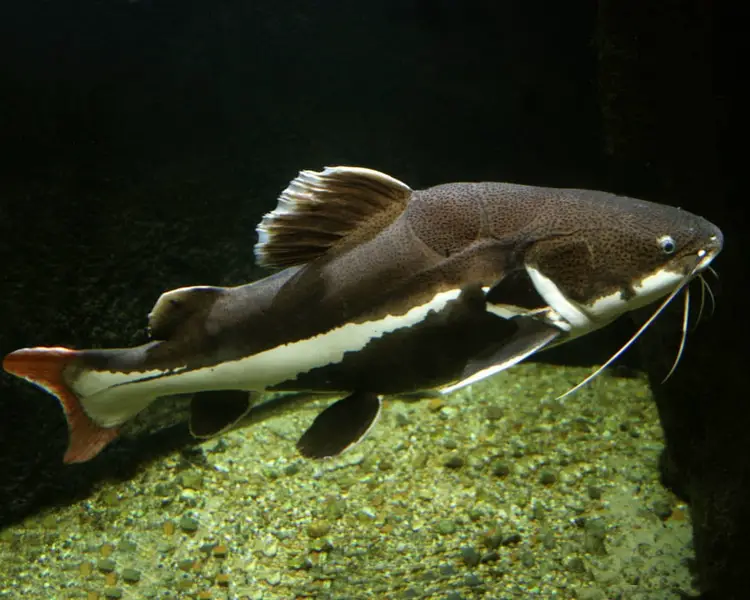
Feeding Redtail Catfish
What do red tail catfish eat? Fish this size need to eat a lot of food, right? You’re right! Redtail catfish are big eaters and will eat just about anything. Just because that is the case, it doesn’t mean that that is what you should do. Simulating their natural diet in the tank will help prolong their lifespan. In nature, the phractocephalus hemioliopterus eats worms, other fish of a smaller size, insects, and vegetation along the bottom of the river basins.
Best Diet for Redtail Catfish
In captivity, you can also opt to feed them smaller fish and worms but substitute the others with shrimp, and some pellet food. Flakes are advised against since flakes don’t generally sink. If you opt for pellet food, you need to choose the sinking variety as that is where your redtail catfish spends most of its time.
They are omnivorous fish but prefer meats. This is why having a supply of frozen food can help satisfy their hunger. They don’t actually need to be fed much. The younger phractocephalus hemioliopterus need food every other day but full-grown redtail catfish can do well with one large meal a week.
The younger phractocephalus hemioliopterus need food every other day but full-grown redtail catfish can do well with one large meal a week.
How often should you feed Redtail Catfish?
You know when it’s time to feed them when your fish become active again. This is because the phractocephalus hemioliopterus need time to digest their food and become lethargic after feeding (sort of like you after turkey dinners). Overfeeding is an issue commonly seen among fish. It’s hard to gauge when some species need food but consistency is key remember that they can go a long while without food.
Don’t feed your Redtail Catfish the meat from mammals. Beef and chicken contain lipids, and your fish won’t metabolize them. Such types of meat can also lead to organ degeneration and excess fat deposits.
Can you eat a redtail catfish? This is a funny question that we are often asked. Because of their size, they are unfortunately considered a game by some. However, the natives of South America don’t generally eat the meat because the fish is often dark in color.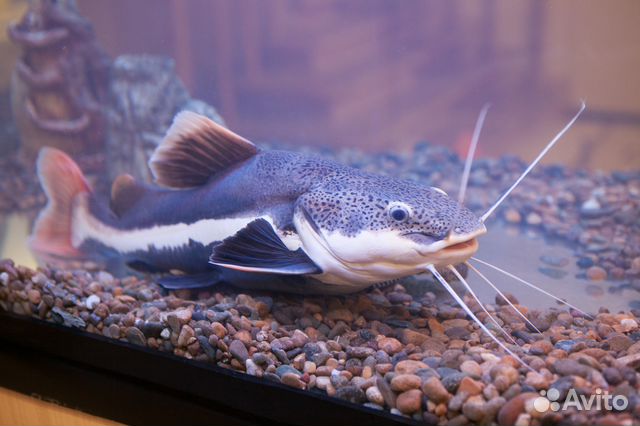
Redtail Catfish Care Level
In a word, caring for the redtail catfish is difficult, which is why they are not recommended for first-time aquarists. They need a large tank due to their size and aren’t the most friendly fish in the sea. On the plus side, they are freshwater fish, which means you don’t need to pay too close attention to the salt levels in the tank.
They are resilient and can adapt to a broad range of habitats, which is why they are considered an invasive species by some. An invasive species means a species that has the power to force out other species that are native to a specific area. This resiliency is also what makes them not as sensitive to certain tank conditions.
Even though they are tough, the right environment is still required to keep them happy and healthy. In captivity, the redtail catfish won’t live as long as it could potentially in its natural habitat. Their size is again something to consider. There are many cases of redtail catfish outgrowing the aquarium at home and because the aquarist cannot accommodate it anymore, they are donated to aquariums.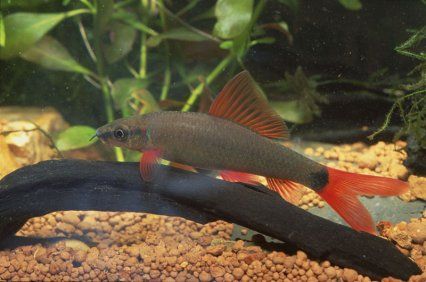
If you do not have an aquarium large enough to house the redtail catfish until maturity, we would advise you to search for another species that is of a more reasonable size.
Redtail Catfish Behavior and Temperament
Fish are either peaceful or aggressive, but these catfish although many agree are aggressive, can fall somewhere in between. Redtail catfish are predatory freshwater fish. If these natural instincts kick in, then some may argue that they are quite aggressive. Factors that influence their temperament and behavior include the environment.
Are Redtail Catfish lone or societal in nature?
When they are young, they can be a little shy or nonsocial. So, to help them in overcoming their shyness, you should offer sufficient space to hang out, such as dens and caves. Besides, it will be much better for you to keep your aquarium out in the open, where you spend a lot of time. This will help your fish to get accustomed to witching and interact with you.
Redtail Catfish generally love to swim at the bottom of the tank. When they are adults, you will find them remaining motionless for hours. Due to their completely evolved receptors and stealth capability, they are the predators that can wait for hours for their prey.
They have a bad habit of putting anything in their mouths. They can even swallow the items. This can be dangerous for your fish and can also lead them to choke. They can even die due to this. So, while adding things to the aquarium, don’t use objects that will easily fit into your fish’s mouth.
Your tank setup will largely dictate how your fish acts. However, the most common display of behavior by the redtail catfish is roaming the bottom of the tank. They slowly pace around the bottom of the tank as most other catfish do. Before the catfish matures, some aquarists say that they can be quite timid. Giving them lots of places to hide can help.
They love to live with their kind or other catfish families. But that doesn’t mean they will not live with others. Redtail catfish can be an ideal community fish if you use fish of the same size. In large public aquariums, they can easily live in large groups. Redtail Catfish are not at all venomous. However, they can be very predatory towards the things they find smaller than them, such as crabs, shrimps, snails, and more.
But that doesn’t mean they will not live with others. Redtail catfish can be an ideal community fish if you use fish of the same size. In large public aquariums, they can easily live in large groups. Redtail Catfish are not at all venomous. However, they can be very predatory towards the things they find smaller than them, such as crabs, shrimps, snails, and more.
Redtail Catfish Tank Mates
Imagine a single catfish floating around with no friends in a sparse tank. The situation seems pretty bleak, but it’s okay, you can add some tank mates (on the condition that they are suitable of course). It’s tough to find the right aquarium buddies for these fish because they are large, somewhat aggressive, and will eat almost anything. The phractocephalus hemioliopterus eat smaller fish, so definitely make sure the tank mates you select are not much smaller.
Due to their large size and the fact that Redtail Catfish consume smaller fish, choosing a good tank mate can be a challenging task for you.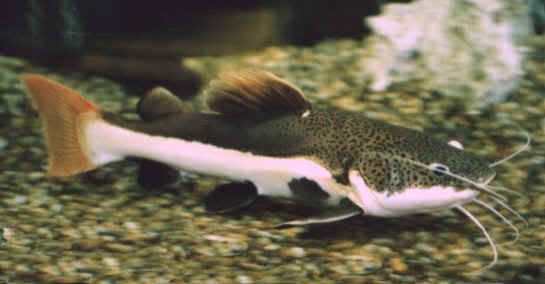 One of the most common issues is that most types of freshwater aquarium fish are very smaller than the Redtail Catfish. When getting tank mates for your Redtail Catfish, you should consider the size first.
One of the most common issues is that most types of freshwater aquarium fish are very smaller than the Redtail Catfish. When getting tank mates for your Redtail Catfish, you should consider the size first.
Ideal Redtail Catfish Tank Mates
When they are small, you can keep them with fish of the same size. For example, Angelfish, Gouramis, Silver Dollars, and Tiger Barbs are good tankmates until your catfish outgrows them. Even though they are voracious, they are not that much aggressive. They can live comfortably with the below and with other bottom dwellers.
Some of the good tank mates for your Redtail catfish can be Stingrays, Pacu, Arowanas, Adult Plecostomus, Umbees, Peacock Bass, Oscars, and other large fish.
Breeding Redtail Catfish
Breeding with these large fish is extremely difficult. In a regular aquarium, even one of 2000 gallons may not be large enough for 2 of these might catfish and this makes it tough to create the circumstances in which they mate. Even in large ponds, it can be difficult for successful breeding.
Even in large ponds, it can be difficult for successful breeding.
Compatibility
Look for fish that are the same size or larger with a focus on non-aggressive temperament. Introduce your catfish to his or her new friend early on so they have time to get acquainted. To minimize trouble, those that do go ahead in keeping redtail catfish usually only keep one. Adding more creatures to the tank only adds more issues such as tank size and having to add some sort of substrate and plants to accommodate the other species can compromise your catfish.
Beautiful stingrays can be optimal tank mates. Some beautiful smaller sharks such as the iridescent shark can also hold their own against the phractocephalus hemioliopterus. Ideally, though, we suggest keeping your catfish solo in a tank.
Redtail Catfish Common Diseases and their Treatment
Though hardy, they are not immune to some diseases. Just like most aquarium fishes, stress, poor-quality water, and an unhealthy diet are some of the risk factors that can severely affect your Redtail Catfish’s health. Some of the most common health issues that your Redtail catfish may develop are:
Some of the most common health issues that your Redtail catfish may develop are:
Fin Rot
This is one type of bacterial infection that can affect most freshwater fishes. When it happens, the Redtail catfish’s edge will begin to move away due to the adverse bacterial activity. If not treated soon, this can affect other parts of your Redtail Catfish. You may see discoloration, and your fish will gradually lose appetite and may develop lethargy. In some cases, inflamed patches can be seen on your fish body. To treat this condition, you can use different antibacterial medications like amoxicillin or fish doxy. If you are using this for the first time, you can take the help of an expert.
Ich
It is quite common for Ich to affect the fish that are under stress. Different factors commonly cause this, for example, pH variations, increase in temperature, and more. Some common symptoms to consider here are white spots on the body, rapid breathing, and glancing. You can try changing water or can check the pH level.
Ammonia poisoning
Redtail Catfish can tolerate ammonia. So, if the ammonia content goes up in the water, they will develop health issues. As per the experts, ammonia poisoning can disturb or damage the gills, and catfish will develop respiratory complications. Besides, a higher level of ammonia in water can lead to burning on the fish.
It has been seen that Redtail Catfish exposed to ammonia poisoning can develop red streaks, witness lethargy, and can have torn fins. Besides, your fish may become reclusive. In some cases, your Redtail Catfish can develop aggressive tendencies. But don’t worry at all as this condition is easily preventable. For this, you should constantly check the ammonia level in the aquarium. The experts suggest it should be around 0mg/1.
In the rising level of ammonia, you should try to lower the pH level and keep changing the water constantly. You should also discontinue feeding for around one to two days. Your catfish should start acting normally after a few days.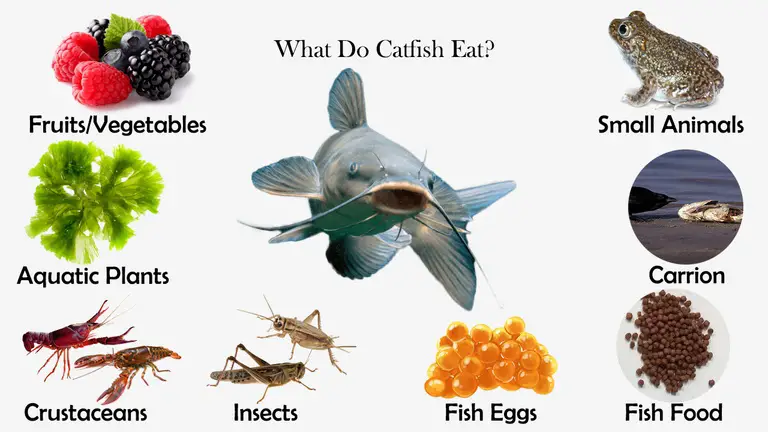
Red Pest Disease
This is generally caused by one type of bacterium. It commonly targets fish’s circulatory system and other organs and tissues. This health issue can lead to internal bleeding. Speaking about the symptoms, some common symptoms are red streaks, bloated stomach, fin or tail rot, and more. Your fish will begin to swim abnormally and come to the surface quite frequently for oxygen. This condition is also treatable.
You can use a combination of different medications, like tetracycline, acriflavine, and monacolin.
Apart from these common Redtail Catfish diseases, they are also prone to fungus, constipation, hemorrhagic septicemia, and more due to their eating habit. So, you should carefully observe your fish for any behavioral changes that can suggest a diseased condition. And you should start treating your fish as soon as possible.
Facts About Redtail Catfish
- They come with a broad head with whiskers and white underneath, extending to the caudal fin from the mouth.
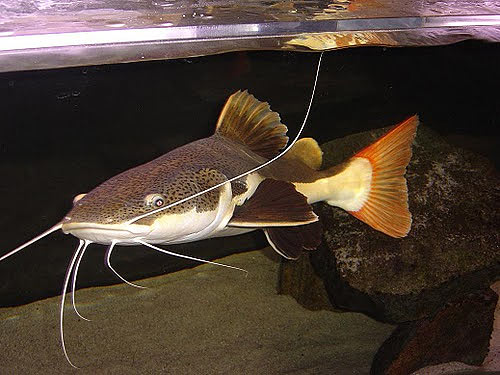 In some rare cases, the tail may find pelvic, anal fins, and the dorsal is also red.
In some rare cases, the tail may find pelvic, anal fins, and the dorsal is also red. - They can grow up to 5 feet and weigh around 80 to 85 kg.
During the daytime, they remain motionless, and they hunt and eat during the night. They are bottom-dwellers. - They can eat small fish, fallen fruits, and crustaceans.
- They have a well-developed tactile sense and a good sense of sight.
- Redtail Catfish generally communicate by producing a clicking sound.
- These fish breed through external fertilization after laying eggs.
- Redtail Catfish species have not been evaluated by IUCN.
Are Redtail Catfish right for you?
They will start cute and small, but with time, they will grow bigger and much faster than other fish. When taken care of and fed properly, they can easily outgrow the aquarists’ fish tank. When the fish attains such a large size, you may need to donate them to a public aquarium or zoo. But the problem is that sometimes they don’t accept privately kept large fish. So, consider this thing while buying a Redtail Catfish.
So, consider this thing while buying a Redtail Catfish.
By offering proper care and a living environment, you can increase the lifespan of your catfish by up to 20 years and more. That’s why Professional and experienced aquarists generally keep Redtail Catfish. So, if you are not quite confident about this, you should get a smaller fish.
The question here is, can you offer them the most comfortable life possible? This will include a large fish tank with sufficient swimming space or a pond. Besides, you will have to feed them properly and change the indoor pond or aquarium water properly.
FAQs (Frequently Asked Questions)
Are Redtail Catfish Hardy?
Well, these are extremely hardy species. Due to their characteristics, they can easily adapt to almost all types of environments and can easily survive in any water condition. However, they also have some preferred elements. You will have to offer them the best life and environment possible. You need to ensure that the water pH and temperature level of the water are at the required level. Besides, you will have to offer them enrichment.
Besides, you will have to offer them enrichment.
What Is The Right Temperature For Your Redtail Catfish?
Even though they are adaptable and hardy fish, they still have some requirements that you need to follow. By meeting those conditions, you can increase their lifespan. As per the experts, the best temperature for your Redtail Catfish is around 20 to 26-degree C. If you have a small Redtail Catfish, then you can use a normal aquarium heater. You will have to use advanced hearing solutions that can cost you more for the pond.
Can They Survive In Cold Water?
Considering their natural habitats and origins, it can be said that they may not be able to survive in cold water. Speaking about their natural habitats, they are large lakes, streams, and rivers, and they never get cold. So, these fish are not ready for cold water. So, if you have an outdoor pond, you should keep it warm during the winters.
How Can Long Redtail Catfish Survive Without Food?
A well-grown and healthy Redtail Catfish can live around three days to one week without consuming any food. Some fish species can live more than two weeks. Whether in an aquarium or nature, your Redtail Catfish has sufficient fat and body mass reserves to skip their meals.
Some fish species can live more than two weeks. Whether in an aquarium or nature, your Redtail Catfish has sufficient fat and body mass reserves to skip their meals.
Who Are Ideal Tank Mates of Redtail Catfish?
They can attack and eat small species, Datnoids, Stingrays, and Gars can be good tankmates of your Redtail Catfish. For best results, you should keep them together from a young age.
We think you may be interested in: Best Pond Liner
Conclusion
The phractocephalus hemioliopterus is quite the trophy fish to keep. It will surely attract a lot of attention to have such a majestic yet menacing predator swimming in a home aquarium. Since they are so large, an aquarist needs to be prepared for all it will take to raise these creatures in captivity. This includes the large aquarium and regular water maintenance. Since they are predatory in nature, we recommend they be kept alone.
You should remember to keep them with you and have a correct setup. Besides, keeping them for around twenty years can attract an expensive food bill as they have a voracious appetite. You will need years of experience, sufficient resources, and space. However, if you have sufficient fun and the means, then they can be a truly amazing giant to keep. It may be a little challenging, but it is not impossible to keep this fish.
Besides, keeping them for around twenty years can attract an expensive food bill as they have a voracious appetite. You will need years of experience, sufficient resources, and space. However, if you have sufficient fun and the means, then they can be a truly amazing giant to keep. It may be a little challenging, but it is not impossible to keep this fish.
Red-tailed catfish or fractocephalus: maintenance and care
Nevada 1976 Red-tailed catfish or fractocephalus: maintenance and care 0 Comment
Fractocephalus, or Orinoco catfish is a beautiful fish, but very large and predatory. In order to keep such a catfish, you must have an aquarium of at least 500 liters. The growth of the red-tailed catfish is not limited to displacement, it will still grow at least half a meter in a year, and in the future it will add 30-40 centimeters.
General information
Red-tailed catfish, or fractocephalus, is a large predatory fish that lives in the hot climate of South America and in the Amazon River Valley. Under natural conditions, it reaches truly enormous sizes, up to 1.8 meters. The weight of an adult reaches 80 kg.
Under natural conditions, it reaches truly enormous sizes, up to 1.8 meters. The weight of an adult reaches 80 kg.
But let's not delve into folklore. In the modern world, despite its size, fractocephalus is popular with aquarium keepers. Of course, more often it is bought for facilities like zoos, but not always.
It should be noted that in the closed space of the aquarium, the catfish grows to a smaller size than in the natural environment. But despite this, he still needs a very large aquarium with a volume of 300 liters to 6 tons, so that he can move freely and not deny himself anything.
Is it worth it to get a red-tailed catfish
It is a huge rarity to meet this fish in home aquariums, since fractocephalus reaches huge sizes and needs a reservoir of at least 7.5 tons of water, which is almost impossible to organize at home. Despite the fact that catfish will feel comfortable with neighbors of the same size, it is not possible to find such fish, let alone keep them.
Don't be fooled by the "modest" size of young individuals. Fractocephaluses grow very quickly. In just a few months, they will grow to incredible sizes. Most often, red-tailed catfish are bred as a food product. Their meat is considered an exquisite delicacy.
The life cycle of a catfish is about 20 years. If you still want to have such an unusual pet in the aquarium, you need to be prepared for great difficulties. A cramped aquarium and poor-quality food are death for red-tailed catfish.
Appearance
Fractocephalus looks quite interesting. It has a gray back with spots and a white belly. The body of the fish is elongated, the head is large and flat. It has 2 large eyes located on the sides.
The catfish has 3 pairs of whiskers. Two of them are located on the lower jaw of the fish, and one on top. Remarkably, the third pair is much longer than the rest.
Caudal fin brightly colored from light orange to bright red. This is how the fish got its name.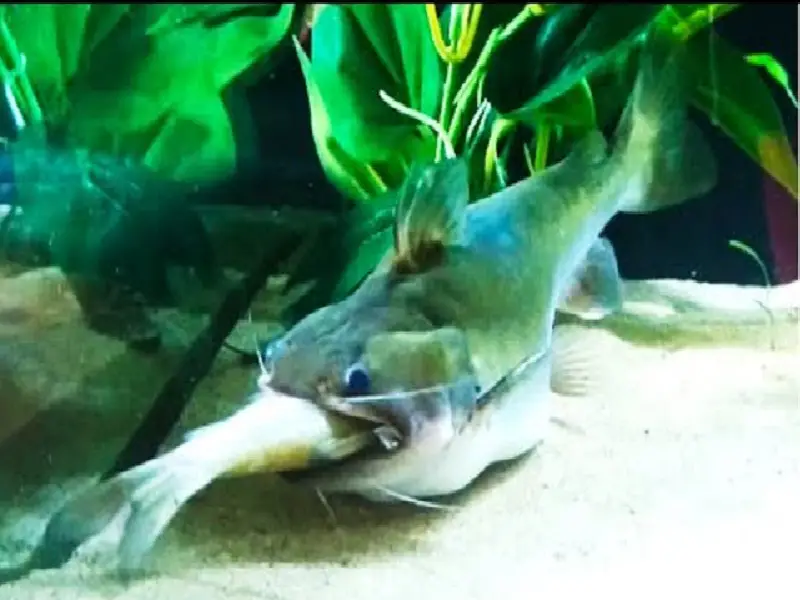
It should be noted that Fractocephalus grows very quickly, so young specimens are usually kept in aquariums. It is noteworthy that such fish are also bred as a source of meat on farms, and their meat is considered very tasty.
Feeding
Redtail catfish is omnivorous. Moreover, he is phenomenally gluttonous. He will gladly eat everything that he will be given and in any quantities. To avoid obesity and related diseases, it is necessary to strictly follow the feeding schedule and not overfeed the catfish. You can feed it with anything, fish love and willingly eat all kinds of live, dry or frozen food, but fresh meat is a particularly useful and favorite option. Young fish can be fed with shrimp, bloodworm, squid, finely chopped white fish fillet. Adults are recommended to feed raw capelin (it can be cut into pieces right with the bones), small live fish, chicken heart or liver (not often, as an exception or treat).
Try to diversify the diet of fish, they tend to get used to one type of food and subsequently refuse others.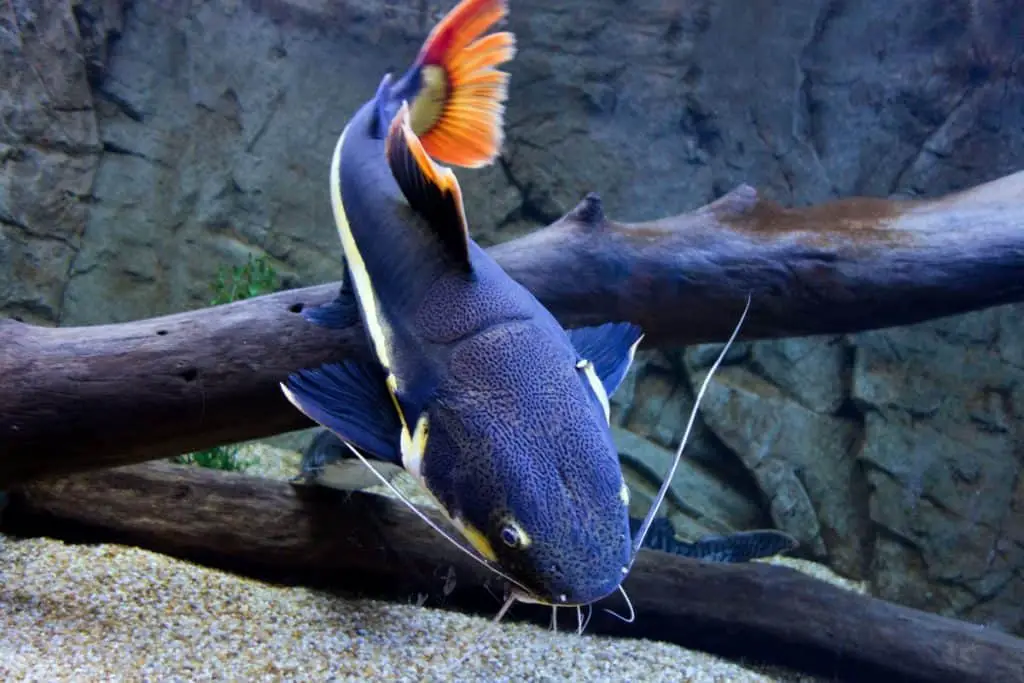 Fracocetals quickly remember the time of feeding and always swim up to the glass in anticipation of food. These catfish are easily tamed and with very little effort you can easily train your aquarium pet not to be afraid of hands.
Fracocetals quickly remember the time of feeding and always swim up to the glass in anticipation of food. These catfish are easily tamed and with very little effort you can easily train your aquarium pet not to be afraid of hands.
Compatibility
Redtail catfish are an extremely popular fish in show and community aquariums, where they are often housed with other large fish such as black pacu and other large catfish.
Even as juveniles only a few centimeters long, they are capable of swallowing many of the most common aquarium fish (such as blue neons or guppies) and should only be housed with other relatively large species.
Although the redtail catfish will hesitate to swallow any small fish, it is quite peaceful and can be kept with fish of equal size. True, this requires an aquarium that you can hardly keep at home.
Most often it is kept with large cichlids, or with other catfish, such as the tiger pseudoplatystom.
Please note that catfish are often underestimated, and they eat fish that they seem unable to swallow.
They guard the territory and can be aggressive towards relatives or catfish of another species, so it is not worth (and hardly possible) to keep several adults.
Redtail catfish: keeping in captivity
Since the fish is a very voracious predator, it should not be placed in the same aquarium with smaller neighbors, because it will simply eat them. However, it is also not recommended to keep her alone.
Large cichlids, other types of catfish and any fish that will not fit in his mouth will be excellent neighbors for the red-tailed catfish. Moreover, the possibility of eating your neighbor fractocephalus should by no means be underestimated.
Catfish are predominantly nocturnal, so the aquarium should have hiding places for daytime activities. Lighting is necessary diffused, catfish do not like bright light.
Coarse gravel, sand are suitable as soil. It is noteworthy that catfish love to burrow into shallow soil.
There should be no small unstable objects in the aquarium: fish can use them to break or split their dwelling, unsuccessfully wagging their tail.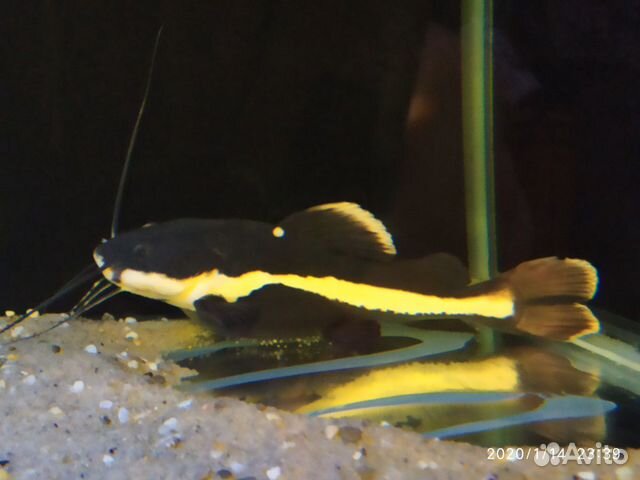
Water temperature should always be kept within 22-28°C, moderate current, hardness 3-13 degrees, pH 5.5-7.2.
In an aquarium where redtail catfish lives, aeration, daily water changes (due to the abundance of waste) and good water filtration are necessary.
If we talk about the nature of fractocephalus, then it is quite slow, it leads mainly near-bottom life. The older the individual, the less mobile it becomes.
Character and behavior
Red-tailed catfish are quite specific aquarium inhabitants with unusual habits:
- They are nocturnal, and prefer to spend daylight hours buried in the ground or hiding in a shelter.
- Character, despite the intimidating appearance, is quite calm and peaceful. Fish can be aggressive if someone decides to encroach on their territory. In this regard, it is not recommended to keep several adults in one aquarium.
- Recognize the owner. When it appears near the aquarium, they will swim up to the glass, begging for food.
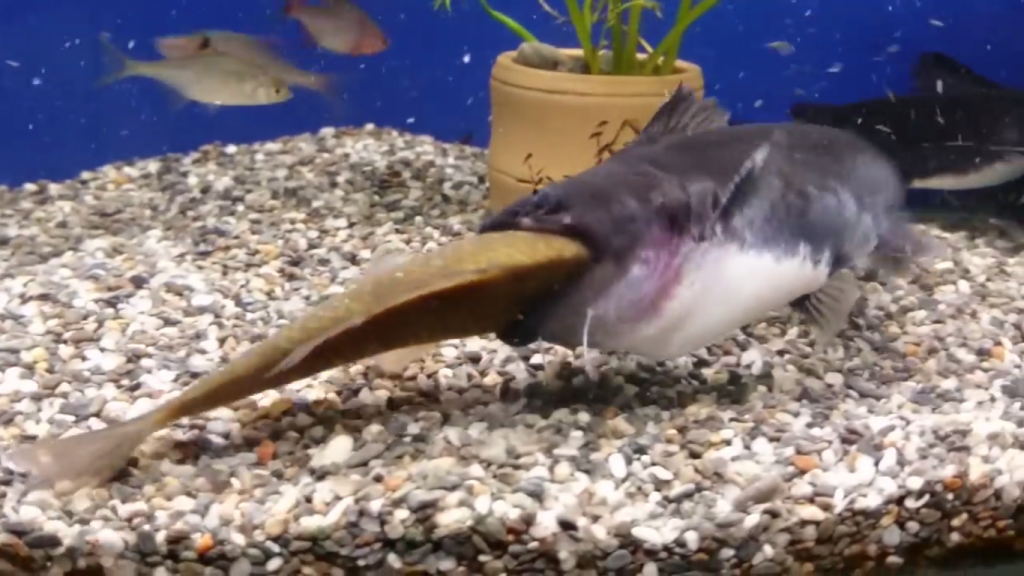 They can take food directly from their hands.
They can take food directly from their hands. - Make sounds that are not like a roar. A similar phenomenon occurs due to the expulsion of a mixture of air and water through closed gills.
Possible diseases
The red-tailed catfish is characterized by excellent, strong health. The only thing he can get sick with is obesity, which develops as a result of malnutrition and frequent feeding. This is a real problem for catfish, often leading to their death.
Malnutrition, especially if the diet contains fresh meat or offal, can lead to dangerous digestive problems. If the disease is not recognized in a timely manner, it will lead to dysfunctions of all internal organs, and it will not be possible to save the catfish.
Reproduction and breeding
It is possible to get offspring from red-tailed catfish at home only if you are a happy owner of a warm decorative pond for several tons of water. It is under such conditions that fish are bred in fish farms in Southeast Asia.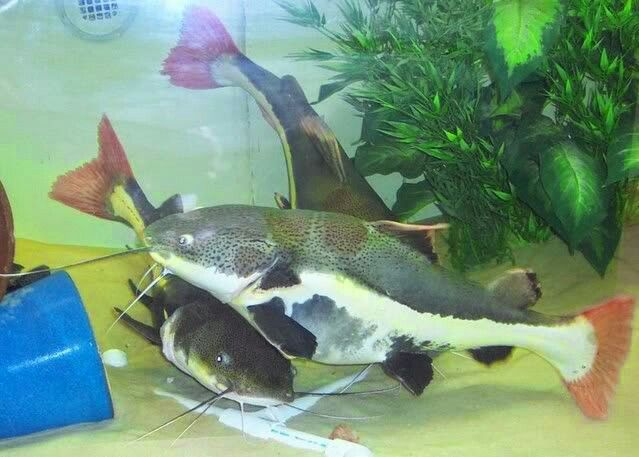
Cases of reproduction in aquarium conditions have not yet been recorded.
CORRIDORAS: DESCRIPTION, TYPES, COMPATIBILITY, CONTENT.
SHARK CATFISH, FRESHWATER SHARK, SIAMESE PANGASIUS: DESCRIPTION AND CONTENTS.
CHACA CHACA
PIMELODUS ORNATUS: DESCRIPTION, CONTENT, PHOTO
care, maintenance, reproduction, compatibility, food, photo review
1 Not all
1 aquarists like small fish species. Some of them tend to keeping a small number of large fish. If you belong to this category and have the opportunity to start aquarium for several tons of water, then an Amazonian handsome man will be an excellent choice - red-tailed catfish. How to keep such a giant at home learn from our article.
Contents
General information
Red-tailed (Orinoco) catfish (Phractocephalus hemioliopterus) is a freshwater ray-finned fish from the family Pimelod, or Flathead catfish.
Characterized quite large in size (up to 130 cm). It's hard to imagine, but such a giant has become a fairly common aquarium fish. Unfortunately, there are still places where juveniles of these catfish are sold as beautiful ornamental fish, silent at times about the immodest sizes of adults. Surprisingly, growth even the volume of the aquarium does not hold back the red-tailed catfish. excellent appetite and boundless gluttony lead to the fact that the fish grows right before our eyes.
It's hard to imagine, but such a giant has become a fairly common aquarium fish. Unfortunately, there are still places where juveniles of these catfish are sold as beautiful ornamental fish, silent at times about the immodest sizes of adults. Surprisingly, growth even the volume of the aquarium does not hold back the red-tailed catfish. excellent appetite and boundless gluttony lead to the fact that the fish grows right before our eyes.
The species lives in South America. It belongs to omnivorous fish, although animal food is preferred. The red-tailed catfish hunts at night from an ambush.
Red-tailed catfish - one of the largest aquarium inhabitantsLocal the population uses red-tailed catfish (which are called "pirarara" here) in as a food object, although their meat is dark in color. View artificially is bred in fish farms of some countries of Southeast Asia, from where also goes on sale as aquarium inhabitants. Is desired trophy in sport fishing.
To scare larger predators or simply unwanted guests, red-tailed catfish able to make loud sounds, reminiscent of the roar of an elephant.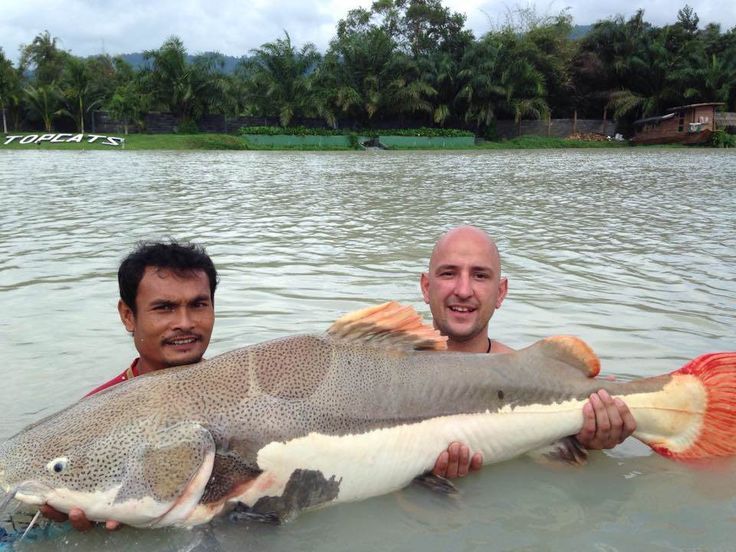 For this fish sharply passes a mixture of water and air through tightly pressed gills. For such The nickname "screaming fish" was attached to the catfish.
For this fish sharply passes a mixture of water and air through tightly pressed gills. For such The nickname "screaming fish" was attached to the catfish.
Worth noting that the Orinoco catfish is unpretentious in content, quickly gets used to the owner and even allows himself to be petted and hand-fed. Often found in public aquariums and aquariums.
Appearance
Redtail catfish has an elongated, powerful body. The head is large, flattened with a wide mouth and big eyes. The mouth opening is bordered by three pairs of long whiskers - one on upper jaw and two on the lower jaw.
All fins well developed. The tail is single, there is a well-defined adipose fin.
Redtail catfish. AppearancePainting Orinoco catfish is quite attractive. The upper body is dark, the lower - white. Numerous black spots are scattered on the head. With a torso the caudal fin, painted bright orange or red, contrasts. The top of the dorsal fin has the same color.
Maximum the recorded body size is 135 cm. In small aquariums, the fish rarely grows more than 60 cm.
In small aquariums, the fish rarely grows more than 60 cm.
The red-tailed catfish is a real long-liver, able to live up to 20 years in captivity.
Habitat
Motherland red-tailed catfish are the warm tropical waters of the rivers of South America, related to the Amazon and Orinoco basins. The water here is soft and acidic, at the bottom you can find a large number of snags that serve as shelters for dusk hunting. Catfish was artificially settled in the southern states of the United States and countries South-East Asia.
Care and content
Considering the huge size of red-tailed catfish, an aquarium for them will need a very big. One individual should account for at least 300 liters, although ideal aquariums for this species are containers for several tons of water. Orinoksky catfish leads a benthic lifestyle, so it is desirable that the bottom area be as possible more. The older the individual, the more time it spends without movement, lying on the bottom.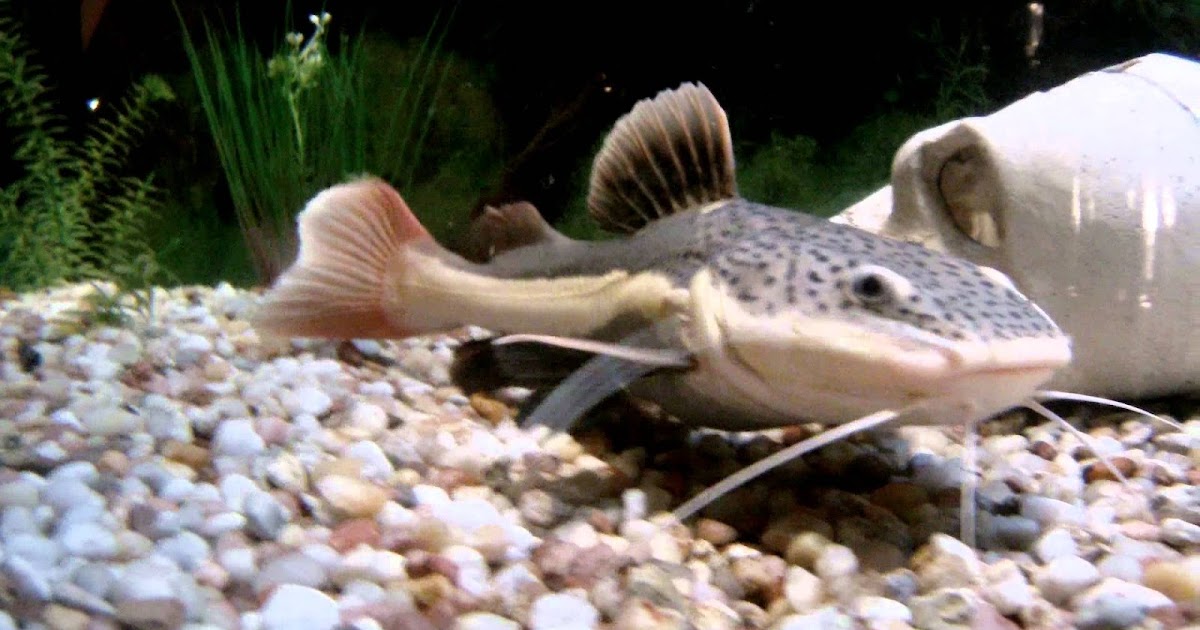
In an aquarium with these catfish should not be abused with decorations. They can easily flip any a loose thing, and in the worst case, even break the glass. Design must be as ascetic as possible. You can put a few large snags, which become a refuge for the fish. It is not recommended to use sand as a soil and small pebble. Red-tailed catfish love to swallow the soil and skip them through the gills. So that the fish do not accidentally damage them, it is better to stop at medium and large stones, or even leave the aquarium without soil, which also makes it easier to clean up leftover food.
Planting live plants in the dwelling of the red-tailed catfish is completely impractical. They will be quickly destroyed by a flat-headed predator.
Redtail catfish will require a large aquarium Natural gluttony and preference for animal food requires the installation of powerful filters and compressors. Red-tailed catfish do not like bright light, preferring soft and subdued ones.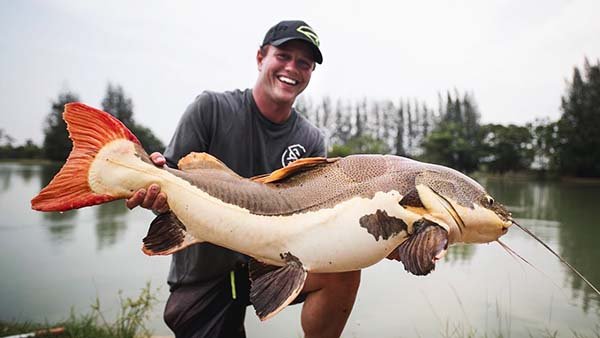 It is important to note that, whenever possible, it is necessary to use an external equipment (for example, a thermostat, a thermometer, etc.), this giant has nothing do not break them even with a small blow of the tail. Needed once a week change 20% of the volume of water in the aquarium.
It is important to note that, whenever possible, it is necessary to use an external equipment (for example, a thermostat, a thermometer, etc.), this giant has nothing do not break them even with a small blow of the tail. Needed once a week change 20% of the volume of water in the aquarium.
Optimal water parameters for keeping: Т=22-28°С, pH=6.0-7.0, GH=2-10.
Compatible
At a glance it seems that the phlegmatic, constantly lying at the bottom catfish is not capable of anyone offend, but this impression is false. Can be done at any time a sharp throw and the unlucky fish will be in the huge mouth of a predator. That's why the joint maintenance of the red-tailed catfish with any species, less than it size is doomed to fail. Moreover, even large fish are not immune from being eaten. Orinoco catfish. Sometimes they grab prey, which is only a third less than them.
Hence the conclusion: the ideal option for keeping red-tailed catfish would be a large aquarium with a single inhabitant.
If the desire to keep catfish with other fish is haunting, then you should pay attention to large aquarium inhabitants - arowana, astronotus, Managuan cichlazoma, black pacu, pterygoplicht, pangasius. However, do not forget that each new tenant of a large size will require a proportional increase in the volume of the aquarium.
Spacious containers, it is possible to contain several individuals of red-tailed catfish, but it is impossible forget about their pronounced territoriality, which often leads to bloody skirmishes.
Redtail feeding catfish
Natural diet red-tailed catfish is extremely diverse. This inhabitant of the Amazon is completely promiscuous and eats everything it can catch: fish, worms, crustaceans and fruits that have fallen into the water. If the opportunity presents itself, he will easily feast on small amphibians, reptiles and even rodents. As seen, preference is given to animal food.
Food base for such a large predator are, first of all, seafood: white fish fillet rocks, mussels, peeled shrimp. It is useful to introduce small pieces into the diet fruits, scalded lettuce leaves.
It is useful to introduce small pieces into the diet fruits, scalded lettuce leaves.
Not recommended feed red-tailed catfish with products from the meat of warm-blooded animals (chicken, beef, etc.), because they are practically not absorbed by fish, can lead to obesity and problems with internal organs.
Unfortunately, most catfish, especially adults, do not favor dry food. Can be offered sinking tablets for bottom fish, e.g. Tetra Tablets TabiMin (XL). There are cases when they fell on catfish according to taste.
Always Offer catfish a varied diet. It was noted that when feeding one and the same product day by day the fish become so accustomed to it that refuse other food. Young fish need to be fed daily. adults is better several times a week. Follow the rules of nutrition remember that catfish will swallow food again and again, they have a sense of proportion is absent, and this is a direct path to obesity and rapid water pollution.
Reproduction and breeding
Obtain offspring from red-tailed catfish at home is possible only if you you are the proud owner of a warm decorative pond for several tons water.





